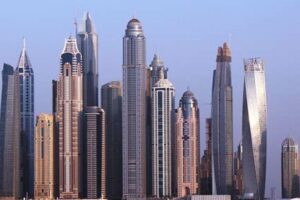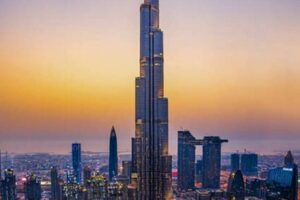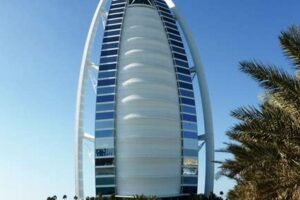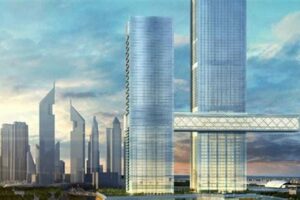Dubai’s skyscrapers are iconic structures that have transformed the city’s skyline, making it one of the most recognizable in the world. These towering buildings, many of which are architectural marvels, have played a significant role in Dubai’s economic growth and global prominence.
The construction boom in Dubai began in the late 20th century, driven by the city’s ambitious development plans and its position as a regional business hub. The tallest building in the world, the Burj Khalifa, is located in Dubai and stands as a testament to the city’s architectural prowess. Other notable skyscrapers include the Princess Tower, 23 Marina, and the Cayan Tower, each with its own unique design and features.
The skyscrapers of Dubai have had a transformative impact on the city, creating new residential, commercial, and retail spaces. They have also attracted international attention and tourism, contributing to Dubai’s status as a global destination. The city’s commitment to sustainable development is reflected in the design of many of its skyscrapers, which incorporate energy-efficient technologies and green spaces.
1. Height
The height of the Burj Khalifa is a defining characteristic of the skyscrapers of Dubai. As the tallest building in the world, it stands as a symbol of the city’s ambition and architectural prowess. The Burj Khalifa’s height has several key implications:
- Engineering marvel: The construction of the Burj Khalifa was a major engineering feat, pushing the boundaries of design and construction technology.
- Vertical living: The Burj Khalifa’s height allows for a significant number of residential units, offering luxurious living spaces with panoramic views of the city.
- Tourist attraction: The Burj Khalifa is a major tourist destination, attracting visitors from around the world who marvel at its height and architectural beauty.
- Global recognition: The Burj Khalifa’s height has brought global recognition to Dubai, establishing the city as a hub for innovation and architectural excellence.
In conclusion, the height of the Burj Khalifa is an integral part of the identity of the skyscrapers of Dubai. It represents the city’s ambition, engineering prowess, and global standing.
2. Architecture
The diverse range of architectural styles showcased by Dubai’s skyscrapers is a defining characteristic of the city’s skyline. This architectural diversity reflects Dubai’s cosmopolitan nature and its ambition to be a global hub. Traditional Arabic designs, such as those seen in the Jumeirah Mosque, blend harmoniously with modern and futuristic skyscrapers, creating a unique and visually striking cityscape.
The Burj Khalifa, the tallest building in the world, is a prime example of Dubai’s modern architectural prowess. Its sleek, minimalist design incorporates sustainable features, such as wind turbines and a double-skin facade that reduces energy consumption. The Princess Tower, another iconic skyscraper, features a unique twisted design that offers panoramic views of the city.
The architectural diversity of Dubai’s skyscrapers has several key implications:
- Cultural identity: The skyscrapers reflect Dubai’s cultural heritage and its ambition to be a global city.
- Tourism: The unique and visually appealing architecture attracts tourists from around the world.
- Economic development: The construction and maintenance of skyscrapers contribute to Dubai’s economy.
In conclusion, the diverse range of architectural styles showcased by the skyscrapers of Dubai is an integral part of the city’s identity and a key factor in its global appeal.
3. Engineering
The engineering behind Dubai’s skyscrapers is a crucial aspect that has enabled the construction of these architectural marvels. The city’s ambitious vision and the expertise of world-renowned architects and engineers have come together to create buildings that are not only aesthetically pleasing but also structurally sound and sustainable.
- Innovative designs: Dubai’s skyscrapers showcase innovative designs that challenge traditional construction methods. The Burj Khalifa, for example, features a unique buttressed core structure that provides stability and reduces wind resistance.
- Advanced materials: The construction of these skyscrapers involves the use of advanced materials, such as high-strength concrete and lightweight steel alloys, allowing for greater heights and reduced weight.
- Sustainable features: Many of Dubai’s skyscrapers incorporate sustainable features, such as energy-efficient lighting systems, rainwater harvesting, and wind turbines, reducing their environmental impact.
- Wind engineering: Dubai’s skyscrapers are designed to withstand the city’s strong winds. Wind engineering studies and advanced wind tunnel testing are conducted to ensure the structural integrity of these buildings.
The engineering feats behind Dubai’s skyscrapers have not only shaped the city’s skyline but have also contributed to the advancement of architectural design and construction techniques worldwide. These buildings serve as testaments to human ingenuity and the relentless pursuit of innovation in the field of engineering.
4. Sustainability
The incorporation of sustainable features in Dubai’s skyscrapers is an integral aspect that aligns with the city’s commitment to sustainable development and environmental conservation. As iconic landmarks and symbols of Dubai’s architectural prowess, skyscrapers play a significant role in shaping the urban environment and influencing the well-being of its residents and visitors.
The adoption of sustainable practices in the construction and operation of skyscrapers in Dubai provides numerous benefits:
- Reduced Energy Consumption: Energy-efficient technologies, such as LED lighting systems, smart building management systems, and renewable energy sources like solar panels, contribute to reducing the energy footprint of skyscrapers. This lowers operating costs and promotes environmental stewardship.
- Water Conservation: Water-saving fixtures, rainwater harvesting systems, and efficient irrigation techniques in green spaces help conserve water resources. These measures are particularly important in arid regions like Dubai, where water scarcity is a concern.
- Improved Indoor Environmental Quality: Green spaces, both within and around skyscrapers, provide natural ventilation, reduce air pollution, and enhance the overall well-being of occupants. Studies have shown that access to green spaces can improve air quality, reduce stress levels, and boost productivity.
- Sustainable Waste Management: Implementing waste management strategies, such as recycling programs, composting, and waste reduction initiatives, helps minimize the environmental impact of skyscrapers and promotes responsible resource utilization.
Furthermore, the sustainability efforts in Dubai’s skyscrapers have a positive impact on the city’s reputation as a forward-thinking and responsible destination. It demonstrates the city’s commitment to environmental protection and aligns with the global movement towards sustainable urban development.
In conclusion, the integration of sustainable features in Dubai’s skyscrapers is not merely a trend but a fundamental aspect of responsible urban planning. It showcases the city’s dedication to creating a sustainable future while maintaining its architectural grandeur and economic growth. By embracing sustainable practices, Dubai’s skyscrapers serve as beacons of innovation and environmental consciousness, contributing to a more sustainable and livable urban environment.
5. Residential
The residential component of Dubai’s skyscrapers is closely intertwined with the city’s overall identity and appeal. These buildings offer opulent living spaces with breathtaking panoramic views of the city, catering to a discerning clientele.
- Unparalleled Views and Lifestyle: The skyscrapers of Dubai provide residents with unparalleled views of the city’s iconic skyline and landmarks. The floor-to-ceiling windows and spacious balconies offer breathtaking vistas, creating a luxurious and exclusive living experience.
- Amenities and Services: Residential skyscrapers in Dubai offer a wide range of amenities and services, including state-of-the-art fitness centers, swimming pools, concierge services, and 24/7 security. These amenities cater to the discerning tastes of residents, ensuring a comfortable and convenient lifestyle.
- Investment Opportunities: The residential units in Dubai’s skyscrapers are highly sought after by investors both domestically and internationally. The strong rental yields and potential capital appreciation make these properties attractive investment opportunities.
- Vertical Communities: The residential skyscrapers of Dubai foster a sense of community among residents. The shared amenities and common areas provide opportunities for social interaction and networking, creating a unique urban living experience.
In conclusion, the residential component of Dubai’s skyscrapers is integral to the city’s appeal as a global destination. These luxurious living spaces offer unparalleled views, exclusive amenities, and investment opportunities, catering to a sophisticated clientele and contributing to Dubai’s reputation as a city of opulence and innovation.
6. Commercial
The commercial aspect of Dubai’s skyscrapers is inextricably linked to the city’s status as a global business and financial hub. These iconic structures house a multitude of world-renowned businesses and financial institutions, contributing significantly to Dubai’s economic growth and global prominence.
- Corporate Headquarters: Many multinational corporations have established their regional or global headquarters in Dubai’s skyscrapers, including companies from diverse industries such as finance, technology, and energy.
- Financial Hub: Dubai International Financial Centre (DIFC) is a key financial hub located within the skyscrapers of Dubai. DIFC houses leading banks, investment firms, and financial institutions, playing a vital role in the emirate’s financial sector.
- Business-Friendly Environment: Dubai’s skyscrapers provide a business-friendly environment with state-of-the-art infrastructure, connectivity, and legal frameworks that support the growth and success of businesses.
- Global Connectivity: The skyscrapers of Dubai serve as gateways for international trade and investment, facilitating business connections between the Middle East, Asia, and the rest of the world.
In conclusion, the presence of world-renowned businesses and financial institutions in Dubai’s skyscrapers is a testament to the city’s strategic importance as a global business and financial center. These skyscrapers not only contribute to Dubai’s economic growth but also enhance its global connectivity and competitiveness, solidifying its position as a prominent player in the international business arena.
7. Tourism
The skyscrapers of Dubai have become iconic tourist destinations, attracting visitors from around the world. Their architectural marvels, world-class amenities, and unique experiences make them a must-visit for tourists seeking an unforgettable urban adventure.
- Architectural Wonders: Dubai’s skyscrapers showcase a diverse range of architectural styles, from traditional Arabic to modern and futuristic designs. The Burj Khalifa, the tallest building in the world, is a prime example of engineering prowess and a popular tourist attraction.
- Observation Decks: Many skyscrapers in Dubai offer observation decks that provide breathtaking panoramic views of the city. Visitors can ascend to these decks to capture stunning photos, admire the city’s skyline, and witness the vibrant urban life below.
- Shopping and Entertainment: The skyscrapers of Dubai house world-class shopping malls and entertainment venues. The Dubai Mall, located at the foot of the Burj Khalifa, is one of the largest shopping malls in the world and offers a wide range of retail, dining, and entertainment options.
- Cultural Experiences: Some skyscrapers in Dubai incorporate cultural elements into their design and offer visitors opportunities to experience Emirati culture. For instance, the Jumeirah Emirates Towers feature a museum dedicated to Emirati heritage and culture.
In conclusion, the skyscrapers of Dubai have become major tourist attractions due to their architectural significance, observation decks, shopping and entertainment offerings, and cultural experiences. These skyscrapers contribute to Dubai’s tourism industry and enhance its reputation as a global destination for leisure and business travelers.
Frequently Asked Questions about Skyscrapers of Dubai
The skyscrapers of Dubai have garnered worldwide attention and sparked curiosity among many. This section addresses some frequently asked questions to provide a deeper understanding of these architectural marvels:
Question 1: What is the tallest skyscraper in Dubai?
The Burj Khalifa is the tallest skyscraper in Dubai, standing at an impressive height of 828 meters.
Question 2: How many skyscrapers are there in Dubai?
As of 2023, Dubai boasts over 200 skyscrapers that are taller than 150 meters, making it one of the cities with the most skyscrapers in the world.
Question 3: What is the architectural style of the skyscrapers in Dubai?
The skyscrapers of Dubai showcase a diverse range of architectural styles, from traditional Arabic to modern and futuristic designs, reflecting the city’s cultural heritage and global aspirations.
Question 4: Are the skyscrapers in Dubai sustainable?
Many skyscrapers in Dubai incorporate sustainable features, such as energy-efficient lighting, water conservation systems, and green spaces, to minimize their environmental impact and promote sustainable urban development.
Question 5: Can tourists visit the skyscrapers in Dubai?
Yes, several skyscrapers in Dubai offer observation decks and guided tours, allowing tourists to experience breathtaking views of the city and learn about the architectural marvels.
Question 6: What is the significance of the skyscrapers in Dubai?
The skyscrapers of Dubai symbolize the city’s economic growth, architectural prowess, and global prominence. They have transformed Dubai’s skyline, attracted tourism, and contributed to the city’s reputation as a modern and dynamic metropolis.
These FAQs provide brief yet informative answers to common questions about the skyscrapers of Dubai. By understanding these aspects, one can gain a deeper appreciation for the architectural marvels that have shaped Dubai’s identity and continue to fascinate the world.
Stay tuned for the next section, where we will delve into the architectural and engineering marvels of Dubai’s skyscrapers.
Tips for Experiencing Dubai’s Skyscrapers
Dubai’s skyscrapers offer a multitude of experiences for visitors and residents alike. To make the most of your visit to these architectural wonders, consider these tips:
Tip 1: Plan Your VisitResearch the different skyscrapers and choose those that align with your interests. Check operating hours and book tickets for observation decks or guided tours in advance, especially during peak season.Tip 2: Capture the ViewsBring a camera with a wide-angle lens to capture the panoramic vistas from observation decks. Visit during golden hour (sunrise or sunset) for optimal lighting conditions.Tip 3: Explore the SurroundingsTake time to explore the areas surrounding the skyscrapers. Visit nearby parks, shopping malls, or cultural attractions to gain a well-rounded experience of Dubai.Tip 4: Consider a Guided TourGuided tours provide insights into the architectural design, engineering marvels, and history of the skyscrapers. Choose a reputable tour operator that offers informative and engaging experiences.Tip 5: Respect the CultureDubai’s skyscrapers are symbols of the city’s culture and heritage. Dress respectfully, especially when visiting areas with cultural significance.Tip 6: Allow Ample TimeSet aside sufficient time to fully appreciate the skyscrapers. Plan for time spent waiting in queues, exploring observation decks, and taking in the surroundings.Tip 7: Stay HydratedDubai’s climate can be hot and humid. Bring water or purchase it from vendors to stay hydrated, especially during outdoor exploration.Tip 8: Capture Unique PerspectivesExplore different vantage points to capture unique photographs of the skyscrapers. Visit the Dubai Frame for a bird’s-eye view or take a boat tour along the Dubai Marina for a different perspective.
Conclusion
The skyscrapers of Dubai, with their architectural marvels, sustainable features, luxurious amenities, and global significance, stand as symbols of the city’s economic growth, ambition, and architectural prowess. These iconic structures have transformed Dubai’s skyline and contributed to its reputation as a modern and dynamic metropolis.
The exploration of Dubai’s skyscrapers reveals the city’s commitment to innovation, sustainability, and cultural heritage. The diverse range of architectural styles, the incorporation of sustainable practices, and the integration of cultural elements showcase Dubai’s aspirations to be a global hub for business, tourism, and innovation.
As Dubai continues to grow and evolve, its skyscrapers will undoubtedly continue to play a significant role in shaping the city’s identity and attracting visitors from around the world. These architectural wonders serve as a testament to human ingenuity and the pursuit of excellence, inspiring future generations to dream big and push the boundaries of architectural design.







